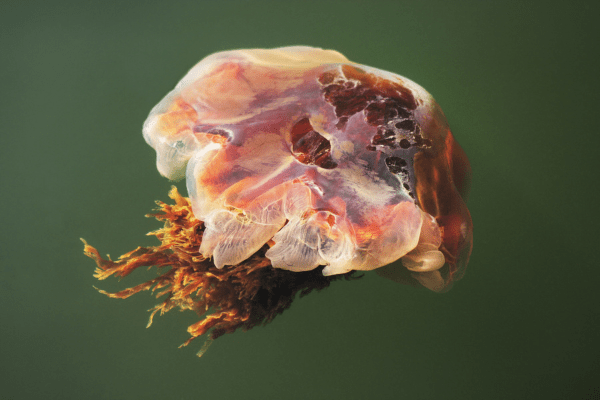Parts of the jellyfish: umbrella, tentacles and oral arms.

The jellyfish is an invertebrate marine animal recognized by its peculiar anatomy. Although depending on the jellyfish species in question, it may vary its morphological characteristics, we differentiate three parts of the jellyfish common. The umbrella, the oral arms (surrounding the mouth) and the stinging tentacles. Aquamalas, along with corals, gorgonians and anemones, belong to the group of cnidarians (knidé = nettle, from the Greek). They are pelagic (open sea) animals, and although they can propel themselves thanks to rhythmic movements of their umbrella, they move basically dragged by sea currents.
These are the parts of the jellyfish you should know about
What is the jellyfish umbrella?
The umbrella of the jellyfish is the part of its body most recognized and visible to all of us: it is the upper umbrella-shaped part. We say it is the most visible, because in most cases, the umbrella of the jellyfish stands out for its large size and/or colorfulness. Among the most common jellyfish in the Mediterranean, the diameter of the umbrella can measure up to 35 centimeters. n exceptional cases, such as the lion's mane jellyfish, the size grows disproportionately, reaching up to 2.5 meters in diameter.

It is also known as bell or dome. Although it is one of the most notorious and identifiable parts of its body, the jellyfish's umbrella is harmless to humans. In this particular area of its anatomy there are no stinging cells. Therefore, if we were to touch it, we would not suffer any sting. The same is not true for the tentacles, which are responsible for triggering the stinging cells and thus causing the annoying stings. There are great differences in the degree of danger of stings depending on the species. Some are not poisonous while others can produce extremely serious stings (as is the case of the nomura jellyfish, which is very common in the waters around Japan, China and Korea). For this reason, and due to the difficulty of distinguishing the different species, recommends not to approach any jellyfish, let alone touch them.
The color of the umbrella of the eagle ray can be very varied: from crimson or purple to yellow or orange tones. The interior of this striking "shell" contains the largest number of nerve receptors. Also the mouth and stomach and the few systems that help it to survive.
Jellyfish tentacles and their stinging "power".
The tentacles of the jellyfish protrude from under the bell, usually surrounding the animal's mouth. They are equipped with stinging cells (nematocysts) and usually have a function related to obtaining food. Upon contact with another organism, the stinging cells are activated and inject venom, sometimes very potent, which can kill the prey in a short time. Tentacles can be very long and are also used to protect themselves from attackers.
Stinging cells are found in the tentacles cnidoblasts. These "stingers" contain an organelle known as a cyndocyte consisting of a highly modified flagellum with a hard filament. Often bristling with barbs. When we brush against the tentacle, the cnidocyst is activated and the filament shoots out like a microscopic stinger that digs into the skin. These flagella inject a special, cytotoxic venom. It destroys cells and can be very intense.
When we brush against the tentacle, the cnidocyst is activated and the filament shoots out like a microscopic sting that pierces the skin.
In the flagella there are hundreds or thousands of these cell-sized cnidoblasts or stingers. This explains why we see a large colored spot in the affected area rather than a simple peck or bite as we would see in any other animal. The cnidoblasts are found almost everywhere in the animal, although the tentacles and mouth are the areas with the highest density of them.
Some cases of jellyfish are special, and only present these cellular structures in very specific areas, but, in general, it is better not to touch any of these animals, in any case. Moreover, a "dead" jellyfish, on the beach, may still have its cnidoblasts armed and ready to do their job weeks later.

The main symptoms of jellyfish stings are swelling, burning and itching.
The jellyfish's oral arms bring its prey close to its mouth.
Last but not least, we highlight the oral arms. Although it may seem to you that they are not part of the vital parts of the jellyfish, nothing could be further from the truth. They play a fundamental role in their captures. The oral arms are the tentacles that surround the mouth. They are used to capture prey and transport them to the mouth. There is a great variety of shapes, sizes and colors.
It is very common to confuse the oral arms with the stinging tentacles. Especially in those jellyfish species in which both are of similar length. Such is the case of the jellyfish Pelagia Nocticula - one of themost frequent specimens in the Mediterranean - . It is also the case of the jellyfish Chysaora hysoscella. This species is more frequent in the Atlantic, but it is also often caught in the Mediterranean. The sting of Chysaora hysoscella is highly dangerous. It causes itching and burning at the beginning and immediately afterwards skin lesions such as erythematous and edema appear. Even welts may appear, which may take time to disappear.
Other peculiarities of the jellyfish body
- They are radially symmetrical
These beings are symmetrical because of a central axis that runs through the length of their body. They have an upper and lower part, but no left or right sides. They are different from other types of animals (such as mammals, reptiles, fish, birds and arthropods) which exhibit bilateral symmetry.
- Your mouth also functions as an intestine
Their digestive system is extremely rustic, with a single, simple opening. These animals ingest food through their mouth, located in the lower part of their bell. The food is digested in a sac-like structure (called the coelenteron or gastrovascular cavity). Waste material is also expelled through the mouth. This cavity then functions in two ways: as a stomach and as an intestine.
- Can produce light
Despite having a very advanced anatomy, some jellyfish are able to emit light to attract prey or when they are in danger. They have a light protein on the back of their body; some use it to defend themselves and others to attack. The jellyfish Pelagia Noctiluca is the best known for its luminescent qualities. It inhabits all oceans, but tends to be found mainly in the Mediterranean Sea.
- They move like jets
A common analogy used to describe how jellyfish move in water is the one that refers to their movement as "a simple form of jet propulsion". It takes in water inside its muscular bell and subsequently squirts it out, creating a jet of water that propels it forward. It also takes advantage of water currents to move.
- They have 24 eyes around their body
They are almost as advanced as those of humans. While we have one pair of multipurpose eyes that detect color, shape, size and light intensity, cube jellyfish have four types of eyes with different purposes. The most primitive ones basically function as light/dark detectors to guide their navigation, and are the ones that all other jellyfish have. The two most advanced ones detect shape and serve to keep them within the safe territory provided by the underwater vegetation. The rest of the primitive eyes have them around the body as if forming a belt.
If you found this information about the parts of the jellyfish useful, please share it with your family and friends. Thanks for reading. See you in the next post.








